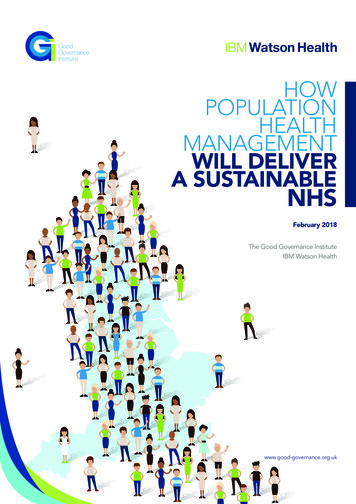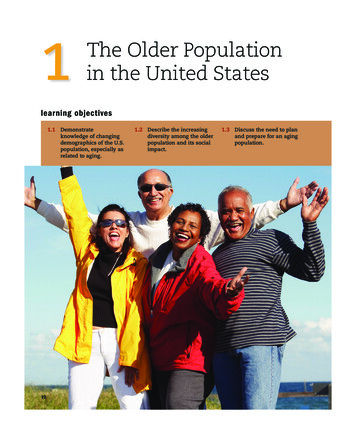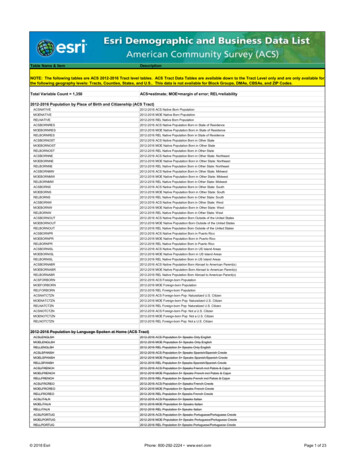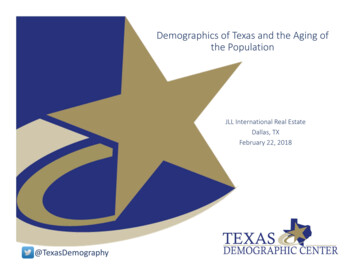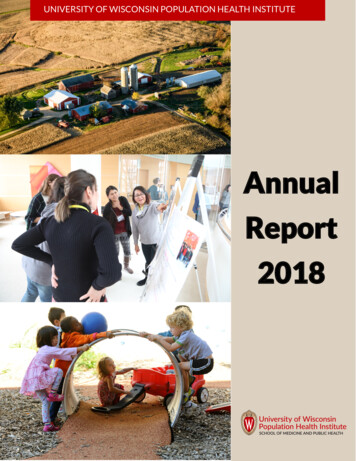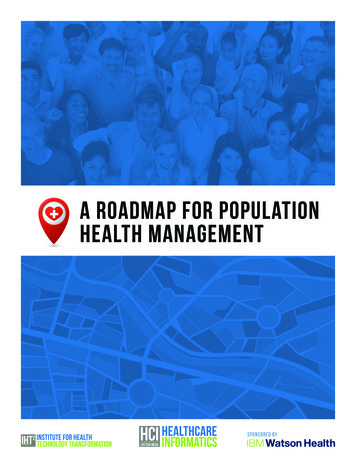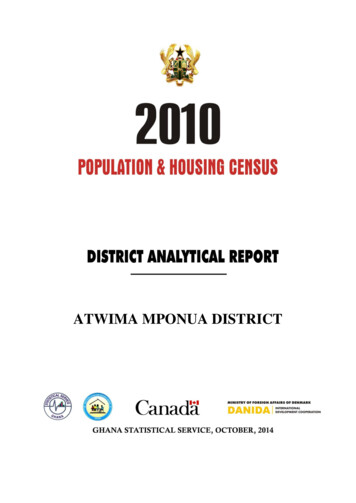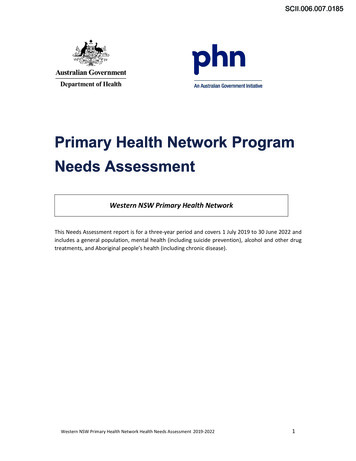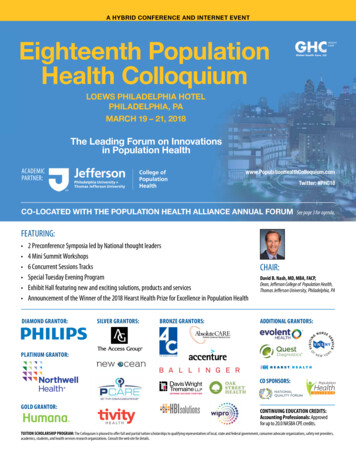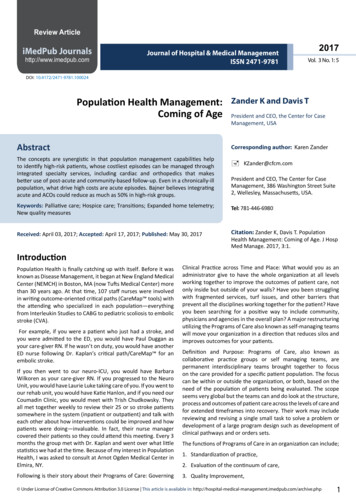
Transcription
Review ArticleiMedPub Journalshttp://www.imedpub.comJournal of Hospital & Medical ManagementISSN 2471-97812017Vol. 3 No. 1: 5DOI: 10.4172/2471-9781.100024Population Health Management:Coming of AgeAbstractZander K and Davis TPresident and CEO, the Center for CaseManagement, USACorresponding author: Karen ZanderThe concepts are synergistic in that population management capabilities helpto identify high-risk patients, whose costliest episodes can be managed throughintegrated specialty services, including cardiac and orthopedics that makesbetter use of post-acute and community-based follow-up. Even in a chronically-illpopulation, what drive high costs are acute episodes. Bajner believes integratingacute and ACOs could reduce as much as 50% in high-risk groups. KZander@cfcm.comPresident and CEO, The Center for CaseManagement, 386 Washington Street Suite2, Wellesley, Massachusetts, USA.Keywords: Palliative care; Hospice care; Transitions; Expanded home telemetry;New quality measuresTel: 781-446-6980Received: April 03, 2017; Accepted: April 17, 2017; Published: May 30, 2017Citation: Zander K, Davis T. PopulationHealth Management: Coming of Age. J HospMed Manage. 2017, 3:1.IntroductionPopulation Health is finally catching up with itself. Before it wasknown as Disease Management, it began at New England MedicalCenter (NEMCH) in Boston, MA (now Tufts Medical Center) morethan 30 years ago. At that time, 107 staff nurses were involvedin writing outcome-oriented critical paths (CareMap tools) withthe attending who specialized in each population—everythingfrom Interleukin Studies to CABG to pediatric scoliosis to embolicstroke (CVA).For example, if you were a patient who just had a stroke, andyou were admitted to the ED, you would have Paul Duggan asyour care-giver RN. If he wasn’t on duty, you would have anotherED nurse following Dr. Kaplan’s critical path/CareMap for anembolic stroke.If you then went to our neuro-ICU, you would have BarbaraWilkoren as your care-giver RN. If you progressed to the NeuroUnit, you would have Laurie Luke taking care of you. If you went toour rehab unit, you would have Katie Hanlon, and if you need ourCoumadin Clinic, you would meet with Trish Chudkowsky. Theyall met together weekly to review their 25 or so stroke patientssomewhere in the system (inpatient or outpatient) and talk witheach other about how interventions could be improved and howpatients were doing—invaluable. In fact, their nurse managercovered their patients so they could attend this meeting. Every 3months the group met with Dr. Kaplan and went over what littlestatistics we had at the time. Because of my interest in PopulationHealth, I was asked to consult at Arnot Ogden Medical Center inElmira, NY.Following is their story about their Programs of Care: GoverningClinical Practice across Time and Place: What would you as anadministrator give to have the whole organization at all levelsworking together to improve the outcomes of patient care, notonly inside but outside of your walls? Have you been strugglingwith fragmented services, turf issues, and other barriers thatprevent all the disciplines working together for the patient? Haveyou been searching for a positive way to include community,physicians and agencies in the overall plan? A major restructuringutilizing the Programs of Care also known as self-managing teamswill move your organization in a direction that reduces silos andimproves outcomes for your patients.Definition and Purpose: Programs of Care, also known ascollaborative practice groups or self managing teams, arepermanent interdisciplinary teams brought together to focuson the care provided for a specific patient population. The focuscan be within or outside the organization, or both, based on theneed of the population of patients being evaluated. The scopeseems very global but the teams can and do look at the structure,process and outcomes of patient care across the levels of care andfor extended timeframes into recovery. Their work may includereviewing and revising a single small task to solve a problem ordevelopment of a large program design such as development ofclinical pathways and or orders sets.The functions of Programs of Care in an organization can include;1. Standardization of practice,2. Evaluation of the continuum of care,3. Quality Improvement, Under License of Creative Commons Attribution 3.0 License This article is available in: hive.php1
DE MEDICINAJournal of Hospital &ARCHIVOSMedical ManagementISSN1698-9465ISSN2471-97814. Evaluation of the flow of patients through the system,5. Evaluation of care given,6. Evaluation of data (Core measures and HQI data included),7. Implementation of interventions to affect the outcomes ofcare,8. Clinical pathway development and monitoring,9. Use of evidence-based medicine.The role of these groups should be organized around measurablegoals based on data. This gets the groups focused on specificissues that can be addressed immediately. These first tasks getthe groups up and moving fast and developing as a team aroundtheir accomplishments.2017Vol. 3 No. 1: 5Membership depends on the diagnosis group that the teamis working on. The membership should be inclusive with asmany physicians as possible. Membership by physicians can beenhanced by supporting their leadership role with the partnershipleader model. The facilitator makes sure the minutes are doneand sent and the second leader does a lot of the grunt workwhich the physicians don’t like to spend time with. Identifying atime and place that is best for the physicians helps attendance.Once they attend they see the importance of their leadership forthe group and the patient focus of the projects which appealsto them a great deal. At that point they are engaged and theycontinue to be so. We started out with the 2 year contract butmany physicians and members have been on the teams for 4years because they don’t want to give up their projects.2. MD Co-leader,Agenda: The responsibility for the programs of care is to be theoversight of care and anything that involves. They truly are theforum where care decisions are made and disseminated throughthe organization based on researched practice guidelines. Forexample:3. Non MD Co-leader,The Programs of Care have become the primary infrastructure to:4. Administrative Facilitator,1. Review the practice structure inside and outside theorganization,Structure: There are 5 main roles:1. Program of Care Direction/oversight,5. Member.The structure is paradoxically simple and complex. Oversight andcoordination is managed by someone who has the vision of theprograms of care to bring to all the groups. In our organizationthat is the Sr. Director Continuum of Care who also directs theacute- care case management service. Consistency of vision is ofutmost importance in organizations which are under a great dealof change. Having one person as a constant for these groups isimperative.The Leadership of each Program of Care is dual in nature andprovided by clinical experts. One leader of each group is a physicianwho cares for and knows the population of patients well. Thisrole appeals to the physicians because they have always beenthe leader of patient care and now they are in a forum wherethey can educate and foster good care for their patients. Mostphysicians love it. The second leader is a staff clinical expert whocares for these patients daily and engages the staff in evaluatingthe care they and their co-workers render. This is a powerful wayto engage the bedside staff in outcomes of care. We have at thispoint engaged the medical staff in partnership with the clinicalexperts at the bedside. For example: In the Pneumonia/COPDPOC the Physician Leader is a pulmonologist and the clinical leadis a staff nurse from the ICU. This group is facilitated by the Sr.Director of Nursing and membership includes respiratory therapy,education, infection control, ED nursing, and many other staffmembers. This group has seen to the success of our Pneumoniacare provided in the organization. Having reached the 2nd and 1stdecile for this group of patients Facilitation comes from upperlevel management. In our case the AVP’s and VP’s took the roleof facilitator, sending a message to the organization about theimportance of the structure. This arrangement also gets to thefinancial piece right away. When there are discussions about theneed for money to buy something we have someone at the tablethat can say right now whether money is available or not.22. Identify areas that need improvement based on data,3. Making recommendations to the organization and physiciansfor changes in practice or system changes as appropriate,4. Review and put into practice the current guidelines, ordersets, and clinical pathways for patient care,5. Monitor the changes in practice,6. Data analysis,7. Quality improvement,8. Sentinel event review,9. Meeting regulatory requirements for a specific group ofpatients (Core measures, HQI, QIO, JACHO),10. Monitoring the financial impact of care as it is provided forthe group of patients they are monitoring,11. Education of the caregivers, facility and community aboutcore measures and the changes recommended.How to get started: Start with an administrative steeringcommittee.1. Identify the diagnosis groups the organization wants toimpact,2. Identify the oversight person,3. Identify the data group or person,4. Sit down with the leadership and facilitator of each group first,5. Get the groups together and educate them about the process,6. Get started.How to keep going: Staying focused comes from the centralThis article is available in: hive.php
DE MEDICINAJournal of Hospital &ARCHIVOSMedical ManagementISSN1698-9465ISSN2471-97812017Vol. 3 No. 1: 5person who maintains the vision and visits each team toassess forward progress. This oversight person meets with thefacilitators regularly to discuss progress and barriers in the systemto forward progress. This facilitator group brainstorms how toremove the barriers and support the teams in their mission.than only those reimbursable under Medicare and Medicaid feefor-service plans. PACE is a program under Medicare, and statescan elect to provide PACE services to Medicaid beneficiaries as anoptional Medicaid benefit. The PACE program becomes the solesource of Medicaid and Medicare benefits for PACE participants.Case StudyFinancing for the program is capped, which allows providersto deliver all services participants need rather than limit themto those reimbursable under Medicare and Medicaid fee-forservice plans. The PACE model of care is established as a providerin the Medicare program and as enables states to provide PACEservices to Medicaid beneficiaries as state option. The PACEprogram becomes the sole source of services for Medicare andMedicaid eligible enrollees. Individuals can leave the program atany time.The Cancer POC was brought together to review the care ofcancer patients provided in the community. We focused firston the care of the breast patient. There was a concern that thepatient who had an abnormal mammogram was not managedto their best benefit. The process from abnormal mammogramthrough diagnosis and treatment was reviewed and manychanges were made. One such change was the process of thesentinel node biopsy. We found we were finding the sentinelnode 10% of the time. We looked at the process and included theSurgeons, the OR, and the Lab, the pathologist, the oncologistand anyone else who had a hand in the process. We totallychanged our process and some equipment and were able toincrease our rate of finding the sentinel node to 90%. Results likethat speak to the clinicians on the team in a way that no otherquality improvement process has.SummaryThe benefit to the organization is a strong focus on patients andthe care they receive. The movement of organizations and thepractice within and outside the walls has struggled with outcomesand the measurement of outcomes. By concentrating on patientoutcomes the care we give becomes outcome focused care. Thismoves the organization in the direction the JACHO and CMS hasbeen attempting to move us by force. By looking at the care weprovide these teams automatically start to measure outcomes.These teams become the central repository of data and by virtueof the role they have in care management develop responsesto the data, by they are following the QI process of continuousquality improvement.Programs of Care extended to every patient population gobeyond task forces, service lines, and six sigma methods byproducing a permanently aligned structure for the governanceof clinical practice. As such they are not standards for processproblems, but rather standard bearers in a continuously renewedculture [1].PACE: Program of All-Inclusive Care forthe ElderlyThe Programs of All-Inclusive Care for the Elderly (PACE) providescomprehensive medical and social services to certain frail,community-dwelling elderly individuals, most of whom are duallyeligible for Medicare and Medicaid benefits. The PACE programhas been in existence a long time. An interdisciplinary team ofhealth professionals provides PACE participants with coordinatedcare. For most participants, the comprehensive service packageenables them to remain in the community rather than receive carein a nursing home. Financing for the program is capped, whichallows providers to deliver all services participants need rather Under License of Creative Commons Attribution 3.0 LicensePACE eligibilityIndividuals can join PACE if they meet certain conditions: Age 55 or older, Live in the service area of a PACE organization, Eligible for nursing home care, Be able to live safely in the community.PACE program becomes the sole source of services for Medicareand Medicaid eligible enrollees. Individuals can leave the programat any time (Figure 1).Case management and population health/Disease management:Case Management with the help of MSW Social Workers is theengine that makes Population Health work. “From a medicalcase management perspective, disease management can bedefined as an information-intensive series of clinical processesand services across the continuum of health care that identifiesthe medically at-risk population and professionally managespatients in a manner that improves care, promotes wellness,and manages/reduces cost” [2]. This is basically the definition ofcase management/care coordination! As early as the late 1800’spolice identified people in need of food, clothing, and shelter,and women founded charities to meet the need (Table 1).“ the current concept of disease management first emerged in1991 as a strategic response by the pharmaceutical industry tomarketplace forces and the evolution of HMOs into managedcare organization (MCOs) and other forms of more proactiveintegrated care that have the potential to help maintain qualityin an increasingly price-sensitive environment. Historically,case managers have always strived to manage illness through acollaborative approaches aimed at the delivery of high-quality,cost-effective health care. However, this early form of diseasemanagement was implemented primarily .episodic, componentbased delivery system. The increased sophistication, availability,and acceptance of clinical practice guidelines also promise toenhance the ability of case managers to provide true-patientcentered care and wellness management” [3].The process of case management classically follows a pattern: Step 1: Identify at-risk members of the insurance plan,managed care plan, elderly, etc., using criteria,3
DE MEDICINAJournal of Hospital &ARCHIVOSMedical ManagementISSN1698-9465ISSN2471-97812017Vol. 3 No. 1: 5Figure 1 Ranking impact on hospital use.Table 1 Competencies in disease management.Cognitive KnowledgePsychomotor SkillValues/BeliefsIntroductoryDefines, describesPerceptionReceives, listens(Learning; focus on“Me” and the “Task”)1.Defines disease management within 1.Shadows experienced DM staffthe continuum of care2.Discusses data related to2.Reviews HIPAA policies, Patient Bill organization’s target populationof Rights and consent forms3.Describes disease-specific programs3.Learns and uses computer skillsthat the organization sponsors [16]Guided responseFamiliarizationComprehends(Rehearsing; focuson the patient andinformation) [17]1.Understands the disease pathology, 1.Works with preceptor to carryassociated pharmacology and standard out DM program and patientcommunicationstreatment of the disease beingmanaged2.Identifies patient readiness tochange.2.States how DM could enhancepatient autonomy, reduce3.Recognizes patient’s educationalcomplications and appropriately utilizelevel, comorbidities, status ofservicescondition and social network.3.Identify ways that the DM program4.Develops realistic short and longmeets organization’s needs beyond CCterm goals with the patientand DP.5.Enrolls patient in appropriate4.Explain concepts related to patient’sprograms according to criteria1readiness to change6.Practice Motivational Interviewing5.Identifies trends within the patientpopulation being managed.1.Actively listens to patients and coworkers2.Is receptive to the input of others,including alternative ways of doing things3.Treats each patient’s history and currentcondition with confidentiality and respectResponds, questions1.Reflects positive and energetic attitude2.Enjoys patient educator role3.Take opportunities for education andself-management4.Imagines self in patient’s situation5.Communicates teamwork, caring andcompassion6.Describes Motivational Interviewingand how the techniques enhance DMinterventions24This article is available in: hive.php
DE MEDICINAJournal of Hospital &ARCHIVOSMedical lyses(Mastery in1.Analyzes the impact of patientComplexity,comorbidities and designs patientprecepting; focus on specific DM plansothers)2.Identifies the patient impact ofcommunity changes on DM plan3.Makes sound suggestions aboutprogram improvements4.Introduces alternative solutionsto problems addressed in casepresentationsComplex, overt actions2017Vol. 3 No. 1: 5Evaluates1.Strategically uses education and1.Is proactive and takes initiativenegotiation to enhance DM program2.Accepts accountability for results, does notcomplianceblame others2.Serves as a dedicated preceptor3.Values initiatives from public health andwith successful resultsother sectors3.Utilizes all system available4.Explores professional certificationto assist current and potentialopportunitiesparticipants in performanceimprovement4.Performs data collection andcalculates outcome dataExcellence5.Stays current with nationalstandards identified by employer and 5.Links outcomes data to populationbased trendsuses them as benchmarksSynthesizesAdaptsReorganizes usefully(Leading change;focus on largersystem)1.Synthesizes new ideas and currentresearch into potential programchangesInnovation/2.Informally researches alternativetherapies, business models, patienteducational methods, web-basedapplicationsExperiments, researches1.Synthesize “lessons learned” andconceptually stretches them to newapplications to resolve problems1.Develop new DM programs or tools 1.Inspires others and promotes participationto meet the needs of the patient and in new approaches.organizationDiscovery(Creating; focuson the “greatergood” and greaterfunctionality)1.Leads performance improvementgroups within organization1.Articulates the value of strategic change bygiving examples and encouraging others2.Maintains effective relationshipswith community providers toenhance patient access andoutcomes2.Advocates for healthy communities at thelevel external to the organizationInvents, createsValue Maturity2.Formally researches alternative2.Conducts research or major changeprojectstherapies, business models, patienteducation approaches and web-basedapplications Step 2: Provide in-depth assessment of each person,Three different perspectives: Step 3: Determine the benefits of the at-risk populations,whether fee-for-service Medicare, etc.1. Patient/family: “Patient, their families, and other informalcaregivers experience failures in coordination particularly atpoints of transition. Transitions may occur between healthcare entities, and over time and are characterized by shifts inresponsibility and information flow. Patients perceive failuresin terms of unreasonable levels of effort required on the partof themselves or their informal caregivers in order to meetcare needs during transitions.” Step 4: Develop an individual care plan for each person andtheir family(if involved), which might extend for 90 days if thepatients is part of a Bundled Payment risk contract, Step 5: Follow the plan and coordinate the team around theplan, Step 6: Keep data –both outcome and financial--andmeasure the results in the categories of Health (physiologicaland mental), Function (role, work, mobility), Absence ofComplications typical to the diagnosis or co-morbidities, andKnowledge in measureable terms [4].Care Coordination; aka Case Management has been defined bythe AHRQ (after reviewing 40 definitions) as “Care coordinationis the deliberate organization of patient care activities betweentwo or more participants (including the patient) involved in apatient’s care to facilitate the appropriate delivery of health careservices. Organizing care involved the marshaling of personneland other resources needed to carry out all required patient careactivities and is often managed by the exchange of informationamong participants responsible for different aspects of care” [5]. Under License of Creative Commons Attribution 3.0 License2. Health care Professionals: “Patient and family-centeredteam-based activity designed to assess and meet theneeds of patients, while helping them navigate effectivelyand efficiently through the health care system. Clinicalcoordination involves determining where to send the patientnext (sequencing among specialists), what information aboutthe patient is necessary to transfer among health care entities,and how accountability and responsibility is managed amongall health care professionals. Care coordination addressespotential gaps in meeting patient’s interrelated medical,social, developmental, behavioral, education, informalsupport system, and financial needs in order to achieveoptimal health, wellness, or end-of-life outcomes, accordingto patient preferences.”5
DE MEDICINAJournal of Hospital &ARCHIVOSMedical ManagementISSN1698-9465ISSN2471-97812017Vol. 3 No. 1: 53. System Representative: “The goal is to facilitate theappropriate and efficient delivery of health care services bothwithin and across systems.” P. 5.from a three-year period, he and his colleagues have segmentedCHS’ 2.2 million patients into seven segments to inform thehealth system’s care management strategy. The Effect of CMS’s Readmission Penalties and BundledPayments on Case Management,“We are getting ahead of the curve to make sure we have theinfrastructure to be attractive to those commercial payers thatmay want additional care management services that for so longthey have had to provide on their own,” Ashby says. Fragmented health care services by separating patientsdeemed at high risk for readmission (using one of 4 tools:LACE, 8 Ps from the Society of Hospital Medicine, TheVulnerable Elderly Survey, and a modified Charleson Comorbidity scale. “Case managers are the most crucial elements of aneffective PHM team, reported 64% of respondents, slightlyedging out PCPs (60%) and health coaches (55%)” [6]. In population health management, populations areassessed and then segmented across the spectrumof health risk: from Healthy to At Risk to Chronic toCatastrophic and the true cost savings result fromcontinually moving patients down the risk scale [7].In the same article, Curran lists the 4 I’s of a successful PHMprogram:1) Information,2) Incentives to motivate behavior at the employer level and thepopulation level, such as passes to gyms, Weight Watchers,completing the Health Risk Assessment, etc.3) Infrastructure of resources, services, and tools,4) Imperative for technology: personalized messaging andcalling, dashboards for tracking progress, mobile phones andtablets, such as provided by CarePort , RoundingWell andReInforcedCare .“Hospitals and health systems face any number of challenges inmanaging the health of a population. Most important, perhaps,is putting in place a successful population health strategyand changing a health care organization's culture to one thatembraces the Triple Aim as a core tenet. Leaders must have aclear vision and be collaborative, empowering, innovative andtolerant of failure. They, along with their teams, must also learnwhat creates success and brings value to their communities,networks and organizations. Organizations move towardpopulation health, the ones that will be successful will be theones with clarity of vision, a dedication to innovation and change,a commitment to the consumer, and the ability to confront thebrutal facts with relentless optimism and focus” [8].In an article by Lola Butcher about Consumer Segmentationhitting health care, she writes that it can lead to better caremanagement. “Carolinas HealthCare System, operating in morethan 900 locations throughout North and South Carolina, is usingan entirely different approach to segment its patients.Avery Ashby, assistant vice president at the health system’sDickson Advanced Analytics group, leads a population healthanalytics team of data scientists, statisticians, businessintelligence specialists, epidemiologists and others. Using data6The team aggregated data from CHS’ electronic health recordsystem and its billing system supplemented with behavior,consumer and geospatial data that identify the census tract inwhich each patient lives. Instead of segmenting patients by costor diagnosis, the analysts used a sophisticated hierarchical clusteranalysis to “let the data talk for itself,” as Ashby puts it.That means that the team was not looking for a certain numberof segments or trying to sort patients by a set of preconceivedassumptions. Rather, the analytical techniques sorted all patientsinto seven mutually exclusive groups. In six of those groups,patients “clustered” together because of traits they shared:Advanced cancerThese patients, who account for 0.6 percent of CHS’ patientpopulation, clustered together on the basis of their high billedcharges (a proxy for resource utilization) and cancer diagnoses.(Patients with less serious or less costly cancer diagnoses maynot fit into this group because they are more similar to the clinicalcharacteristics in another segment.)Complex chronicThese patients — typically older, low-income, covered byMedicare, widowed, and struggling with behavioral healthproblems and multiple chronic conditions — account for 6.6percent of the patient population.Aging rising riskYounger than patients in the “complex chronic” segment, thesepeople typically are married, commercially insured and have justone chronic condition, such as Type 2 diabetes, that is undercontrol. They make up 16.7 percent of the patient population.Mental health: A large percentage of patients have a mentalhealth diagnosis, of course, but the 0.1 percent who clusteredto create this segment shares some specific commonalities. Theyare older teens and young adults, most of whom are male, whohave serious mental health conditions that require a great dealof support.Pregnancies and deliveriesThese healthy women make up 2.6 percent of the system’spatients.Newborns and toddlersIn general, these are healthy children under age 3 who accountfor 2.5 percent of CHS’ patients.Together, the patients in the first four segments make up 24percent of CHS’ patients — and 76 percent of billed charges. TheThis article is available in: hive.php
DE MEDICINAJournal of Hospital &ARCHIVOSMedical ManagementISSN1698-9465ISSN2471-9781seventh segment — dubbed “sparse information, acute and well”— accounts for 70.8 percent of patients and only 17.4 percent ofcharges.That segmentation allows for care management protocols thattarget specific slices of the patient population. For example,CHS knows that around 145,000 patients fall into the “complexchronic” segment, which is the second most expensive segment.That’s an unmanageable number, Ashby says. But having somuch data about those patients in an enterprise data warehouselets the analysts identify subsets — for example, those complexchronic patients who have increasing year-over-year charges,have a certain combination of diagnoses, have had avoidableutilization and belong to certain demographics — that warrantspecific attention.[9]”In another powerful example of population health management,Cambridge Health Alliance (CHA), an Accountable CareOrganization in 3 neighborhoods, although headquartered inCambridge, MA is using analytics to identify hi dollar patients incombination with high need patients and families. They have 5principles the program is founded on:1. Care management is not the goal: clinical integration towardrealistic outcomes to which all parties can commit is the goal2. One title across settings: Care Management,3. One care manager/”conductor”,4. One plan of care across time and place,5. Patient/family version of plan—calendar and pictures,6. Family is the “other” patient,7. Two “Hubs” are PCMH and ED.“CHA has found that the best ACO strategy for them is aimingat identifying and engaging patients whose complex andcomplicated care needs cannot be addressed by the healthcare system as currently designed. They have learned thatsymptoms of a poor condition are under, over-utilization, or misutilization of the delivery system, frequent ED visits, inpatientstays and readmissions, poor hea
Health Management: Coming of Age. J Hosp Med Manage. 2017, 3:1. Population Health Management: Coming of Age Abstract The concepts are synergistic in that population management capabilities help to identify high-risk patients, whose costliest episodes can be managed through integrated specialty services, including cardiac and orthopedics that makes
